the programs
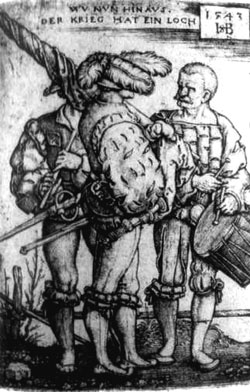
"Where now? The war has a hole."
Songs from the time of the Thirty Years' War
The 30 year war, a trauma in history. In 1617 the 100th anniversary of the Reformation was celebrated with pride and defiance. Already a year later the structure shook,
which had covered the peace between the quarreling confessions for the last decade. A war broke out, which left nothing to think of cruelty, which was ended several times with treaties and peace ceremonies,
only to start again.
There were ballads, folk songs, hymns on war heroes such as Tilly and Gustav Adolf, impressive songs of the Landsknechte, melancholy complaints and (in spite of all) exuberant dances,
hopelessly framed Friedenslieder and impressive chorales from the time of the Thirty Years War. Traced, arranged and presented with historically informed wit and depth through "The Playfords".
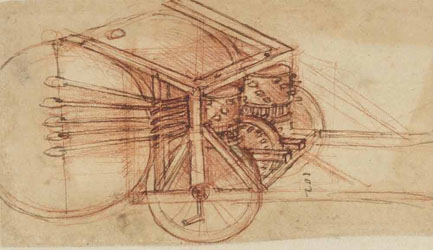
"Das Universalgenie"
zum 500. Todestag von Leonardo Da Vinci
Leonardo da Vinci's work and ideas as a painter, sculptor, architect, anatomist, mechanic, engineer and natural philosopher are still forward-looking, and still allow him to be regarded as a superstar
of the universal scholars of Reniassance. In Milan, Florence and Rome he worked in the most important music centers of the Renaissance. He left great works of art until he died in France in 1519.
The Playfords have created a program with texts by Leonardo da Vinci and compositions by Bartolomeo Tromboncino, Vincenzo Galilei, Francesco di Milano and Josquin Desprez, as well as well-known hits of the time.
„Fa una Canzone“
Italian Renaissance dance music: Frottole, canzone, tarantelle, improvisazioni, amore per la musica!
 With “Fa una canzone”, The Playfords deliver all the greatest hits from 16th and 17th-century Italy! The villanelles, frottole, and balletti written by stars such as Giovanni Giacomo Gastoldi, Orazio Vecchi,
and Claudio Monteverdi were all the rage throughout Europe. Just as with popular music nowadays, performers then sang about love, too, and the dances’ rhythms were meant to be boisterous celebrations of life.
Arranged by the musicians themselves to underscore their cheerfulness and passion, these songs are played with masterful technique and with a healthy dose of Mediterranean charm.
With “Fa una canzone”, The Playfords deliver all the greatest hits from 16th and 17th-century Italy! The villanelles, frottole, and balletti written by stars such as Giovanni Giacomo Gastoldi, Orazio Vecchi,
and Claudio Monteverdi were all the rage throughout Europe. Just as with popular music nowadays, performers then sang about love, too, and the dances’ rhythms were meant to be boisterous celebrations of life.
Arranged by the musicians themselves to underscore their cheerfulness and passion, these songs are played with masterful technique and with a healthy dose of Mediterranean charm.
Listen to excerpts here: CD "Fa una canzone"
„THE HUNT IS UP“ - Shakespeare's Song Book
Tunes and Ballads from the Plays of William Shakespeare (1564 - 1616)
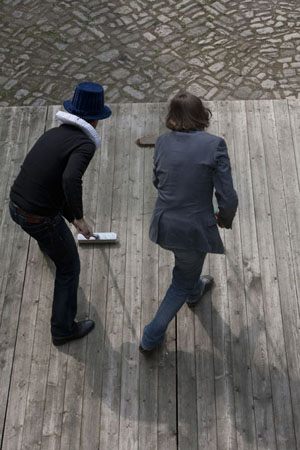
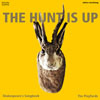 Shakespeare’s works resound with musical allusions and references. These are often meant to provide the audience with background information, but at other times, they serve simply to provoke a smile or even laughter.
But this only works, of course, if the viewer is already quite familiar with the material being referenced. Thus we can also use Shakespeare’s plays to piece together a list of the most popular songs of the time,
a project that has been undertaken by the American musicologist Ross W. Duffin. The Playfords have adopted his Shakespeare’s Songbook as a type of ‘real book’ which inspires and gives rise to their own improvisational play.
Just as Shakespeare’s Globe theatre brought all of London’s social classes together, this work gathers everything from the knee-slapping bawdiness beloved by simpler folk to more artfully wrought aural
allusions aimed at a more distinguished and discerning audience. The result is a musical panorama of late Renaissance English society in its entirety.
Shakespeare’s works resound with musical allusions and references. These are often meant to provide the audience with background information, but at other times, they serve simply to provoke a smile or even laughter.
But this only works, of course, if the viewer is already quite familiar with the material being referenced. Thus we can also use Shakespeare’s plays to piece together a list of the most popular songs of the time,
a project that has been undertaken by the American musicologist Ross W. Duffin. The Playfords have adopted his Shakespeare’s Songbook as a type of ‘real book’ which inspires and gives rise to their own improvisational play.
Just as Shakespeare’s Globe theatre brought all of London’s social classes together, this work gathers everything from the knee-slapping bawdiness beloved by simpler folk to more artfully wrought aural
allusions aimed at a more distinguished and discerning audience. The result is a musical panorama of late Renaissance English society in its entirety.
Listen to excerpts here: CD "THE HUNT IS UP"
"Si ce n’est amour…"
Chansons and dances from the French Renaissance
"And if it isn’t love...", then what could it be? What could fluster you so, make you take leave of your senses, pick you up off your feet to dance or throw you in a melancholy mood? With their collection of French
dance music from the 16th century, The Playfords breathe new life into chansons and dances dating back to the early Renaissance whilst also artfully crafting a bridge into our own modern age: French elegance,
Parisian tango, hints of the Orient, intoxicating dance music. The collection includes the group’s own arrangements and original historical arrangements of compositions by Pierre Sandrin, Pierre Attaingnant,
Jacques Arcadelt, Claudin de Sermisy and Thoinot Arbeau.
Samples:
Tant que vivray
Ce n'est point pour t'estrenner
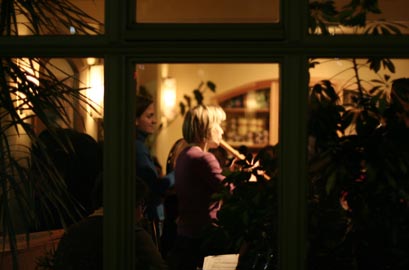 "Luther tanzt"
"Luther tanzt"
Songs from the Reformation and their Secular Roots
 Martin Luther was as deeply defined by his emotions as he was by his learnedness; when convinced, he was convinced unreservedly. This can help to explain how the fun-loving student in Erfurt was transformed into an deeply
ascetic monk who, outraged by the hypocrisy of the Church of his time, ended up inadvertently giving rise to the Reformation. It explains, too, how he then came to toss asceticism aside to draw upon all of the senses –
and especially the power of music – to spread religious tenets amongst the population. In contrast to many of his fellow reformers, he did not make use of Germanised Gregorian chants, but instead put new lyrics to popular melodies,
both well-known and novel. Thus “popular songs, riders’ songs, and mountain tunes made more Christian and moral” were put to use in serving the Reformation. It certainly helped that Luther was a talented lute player
and well versed in the art of counterpoint. His close relationships with Ludwig Senfl and Johann Walter were equally beneficial. He served as a model for countless writers of songs and shaped Protestantism’s
demotic choral tradition. Martin Luther was as deeply defined by his emotions as he was by his learnedness; when convinced, he was convinced unreservedly. This can help to explain how the fun-loving student in Erfurt was transformed into an deeply
ascetic monk who, outraged by the hypocrisy of the Church of his time, ended up inadvertently giving rise to the Reformation. It explains, too, how he then came to toss asceticism aside to draw upon all of the senses –
and especially the power of music – to spread religious tenets amongst the population. In contrast to many of his fellow reformers, he did not make use of Germanised Gregorian chants, but instead put new lyrics to popular melodies,
both well-known and novel. Thus “popular songs, riders’ songs, and mountain tunes made more Christian and moral” were put to use in serving the Reformation. It certainly helped that Luther was a talented lute player
and well versed in the art of counterpoint. His close relationships with Ludwig Senfl and Johann Walter were equally beneficial. He served as a model for countless writers of songs and shaped Protestantism’s
demotic choral tradition.
By rescuing once well-known hymns from the murky waters of the past, The Playfords reveal the cheerful, dance-like character of these church songs, an aspect far too often neglected.
In doing so, they bring back to life those “wicked and vexing ways in which those unprofitable and shameful little ditties of the streets, fields, homes and elsewhere are sung”.
Listen to excerpts here: CD "Luther tanzt"
"Er nymbt kein Blat fuers Maul"
Luther, always ready to raise his glass!
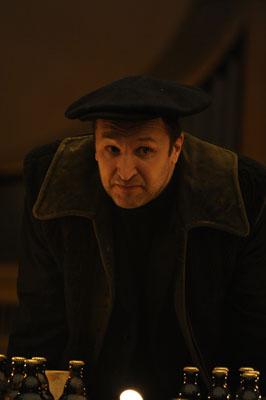
In intimate company, the great reformer would hold forth on god, death, the devil and the entirety of the Lord’s creation in a way that was witty and lyrical, swaggeringly confident, clear-sighted and rational.
There would be talk of man’s most dire enemies and most sublime joys, of the wonders of nature, of the state of marriage, of music, of the writer’s guild or of the celestial rainbow. Luther’s speech was vivid,
lively and eloquent – he was anything but a dusty old clergyman. As a host, he was preacher, singer and a man of letters. Above all he proved himself to be a man who was full of passion and love, want and anger,
fear and hope, someone who sought to amuse without ever losing the thread of his argument, the substance of his beliefs, or the attention of his guests.
Director: Götz Brandt
Starring (Martin Luther): Christian Klischat
Music: The Playfords
The actor Christian Klischat relies solely on original texts to depict a Martin Luther who could be marvellously vivid, course,
boisterous, and even full of doubt. We have chosen the best bits from our programme that we believe reveal a common thread through both the texts and the music.
„Oranges & Lemons“
Dance music from England from around 1700
 In “Oranges & Lemons”, The Playfords draw especially on the collection of songs entitled English Dancing Master (1651), which was published by John Playford.
The Dancing Master met with great success; eighteen new editions had appeared by 1728. The Playfords have skilfully and imaginatively arranged the “Country Dance Tunes”, which are cheerful,
jaunty, dreamy, and sometimes melancholy in turn. With the help of contemporaneous English ballads, they also relate the varied forms that love may take and the political circumstances that shaped the 17th century.
In “Oranges & Lemons”, The Playfords draw especially on the collection of songs entitled English Dancing Master (1651), which was published by John Playford.
The Dancing Master met with great success; eighteen new editions had appeared by 1728. The Playfords have skilfully and imaginatively arranged the “Country Dance Tunes”, which are cheerful,
jaunty, dreamy, and sometimes melancholy in turn. With the help of contemporaneous English ballads, they also relate the varied forms that love may take and the political circumstances that shaped the 17th century.
Listen to excerpts here: CD "Oranges & Lemons"
„Nova! Nova!“
European Advent & Christmas songs from the 14th through the 18th century
 At the heart of the meaning of Christmas is that continual human yearning for a future brighter than the present day. For the Christian world, the birth of Jesus was the moment of renewal that they had long been awaiting,
and the momentousness of that occasion has found expression in various artistic forms, especially in music, over the centuries.
At the heart of the meaning of Christmas is that continual human yearning for a future brighter than the present day. For the Christian world, the birth of Jesus was the moment of renewal that they had long been awaiting,
and the momentousness of that occasion has found expression in various artistic forms, especially in music, over the centuries.
With their fittingly titled CD project “Nova! Nova!” (“Newness! Newness!”), The Playfords turn to Christmas music from the 14th through the 18th century. A core of well-known German melodies are joined by
songs and dances from England, France, and Spain.
An ensemble composed of early music specialists, The Playfords seek to revive the nearly lost tradition of the improvisational musician of the Renaissance and Baroque period.
With their playful but authentic approach, they confer an entire palette of Christmastime emotions, from still reverence to exuberant joy, on music from an age long since disappeared –
all with a few knowing nods to our contemporary world too.
Listen to excerpts here: CD "Nova! Nova!"
|